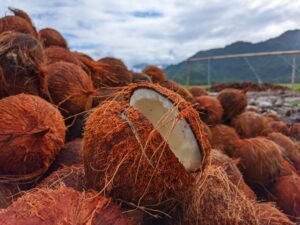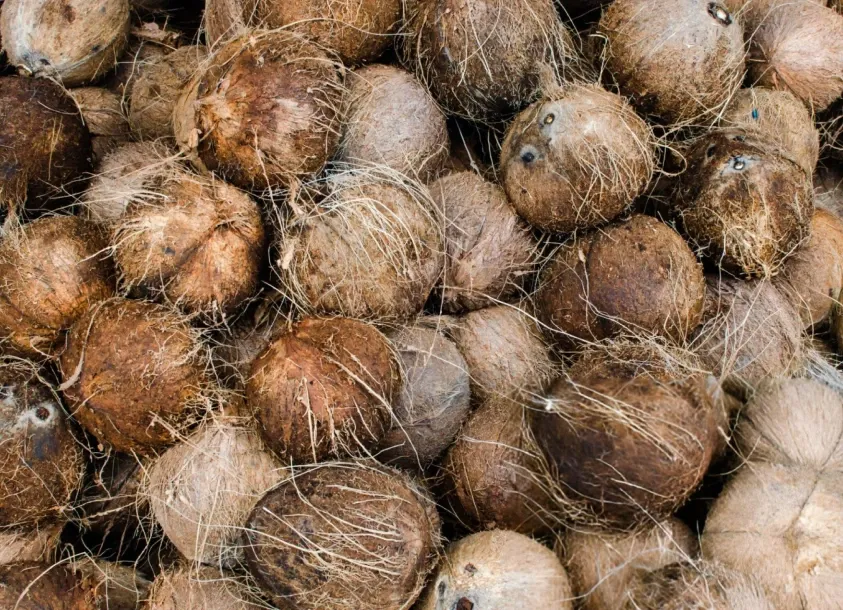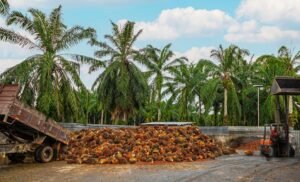
How Indian Exporters Ensure Freshness Through Coconut Export Packaging

The Role of Coconut Export Packaging in Ensuring Freshness
In fact, for Indian coconut exporters, freshness is not just a priority but a commitment. As buyers around the world expect uniformity in quality, the need for coconut export packaging has never been greater. Coconut packaging is essential to maintain coconuts’ freshness, firmness, and appearance for international long-haul shipping. The coconut’s journey will be from humid coastal ports to drier inland places, thus they need to be packaged well to arrive at buyers in good state.
From a farm in Tamil Nadu or Kerala, the coconut’s journey to the UAE, Europe, or Southeast Asia includes harvesting, grading, packing, and shipping. At each of these points, Indian coconut exporters employ specialized packaging materials and techniques to avoid spoilage, moisture loss, or physical damage. Because they would be investing in export packaging, they could ensure freshness standards internationally and provide a reliable product for their international buyers.
From a farm in Tamil Nadu or Kerala, the coconut’s journey to the UAE, Europe, or Southeast Asia includes harvesting, grading, packing, and shipping. At each of these points, Indian coconut exporters employ specialized packaging materials and techniques to avoid spoilage, moisture loss, or physical damage. Because they would be investing in export packaging, they could ensure freshness standards internationally and provide a reliable product for their international buyers.
What Defines Export-Grade Coconut Packaging?
For packaging to be considered export-grade, it must be both protective and efficient. Indian exporters follow specific parameters to ensure packaging meets buyer expectations and complies with trade norms.
- Durable Materials: Use of strong natural fibers like coir or breathable jute gunny bags prevents sweating and mold buildup.
- Moisture-Control Liners: Many exporters include food-safe liners or paper to manage humidity levels inside the packaging.
- Batch Tagging and Labels: Clearly labeled export batches with weight, grade, and port of origin streamline customs and receiving procedures.
- Tamper-Proof Seals: Sealing mechanisms reduce the chances of external contamination during shipping.
- Stackable and Load-Efficient Designs: Packaging is designed for bulk coconut transport, reducing empty space and shipping costs.
These practices together form the backbone of India’s reputation for quality coconut export packaging across international markets.
Innovations That Improve Freshness in Shipping
Every stage of the packaging process has seen coconut exporters in India innovate to keep things fresh for shipping. Most suppliers have started using digital moisture meters for grading purposes, allowing the packing of only coconuts with the ideal internal moisture content. Some go as far as printing QR codes on the labels as a tracking and tracing system to provide the importers batch information and harvest dates .
With regards to packaging, breathable multilayer sacks are increasingly being used, particularly for air cargo. Besides, these bags are strong and will ventilate, thus, sweating and spoilage are reduced. Thermal liners have been used by others for shipments at sea where there are large swings in the temperature of the container.
Such innovations make coconut products not only more stable, bringing longer shelf life over time, but also result in lower loss rates, thus becoming a more reliable commodity for foreign wholesalers and retailers dealing with Indian exports. This is also what makes Indian exporters more important players in the international coconut supply chain.
With regards to packaging, breathable multilayer sacks are increasingly being used, particularly for air cargo. Besides, these bags are strong and will ventilate, thus, sweating and spoilage are reduced. Thermal liners have been used by others for shipments at sea where there are large swings in the temperature of the container.
Such innovations make coconut products not only more stable, bringing longer shelf life over time, but also result in lower loss rates, thus becoming a more reliable commodity for foreign wholesalers and retailers dealing with Indian exports. This is also what makes Indian exporters more important players in the international coconut supply chain.
Bulk Coconut Transport: Packaging Considerations for High Volume Orders
When it comes to bulk orders, packaging efficiency becomes even more critical. Indian suppliers have adapted their practices to suit high-volume international buyers.
- Palletized Loads: Coconuts packed in jute bags are placed on wooden pallets for quick loading and unloading at ports.
- Containerized Shipments: Packaging is optimized for 20-foot and 40-foot containers, ensuring full use of space without compromising ventilation.
- Secondary Carton Packing: Some exporters use cartons with internal dividers for higher-grade husked coconuts bound for premium markets.
- Gunny Bags with Mesh Ventilation: Ideal for semi-husked coconuts sent to the Middle East and Southeast Asia.
By combining these techniques, Indian exporters ensure that the bulk coconut transport process remains smooth, consistent, and suitable for a wide range of climates and destinations.
Regional Approaches by Leading Indian Coconut Exporters
Within the coconut belt in southern India, Tamil Nadu, Kerala and Karnataka pavilion export, adapted their packaging according to contextual local conditions and buyers’ needs . For example, exporters in Tamil Nadu who work mainly with semi-husked coconuts select bigger breathable sacks that are better fit for export. Exporters in Kerala, whose specialty is in husked and mature coconuts, sometimes emphasize moisture-retention techniques and ship in moisture-resistant liners.
Suppliers from Karnataka, instead, cater to national and international customers and deal with more flexible packaging forms, suitable for mixed loads. These exporters are also compliant with certifications such as APEDA and FSSAI, whose audits will often cover packaging standards.
Regional variations such as these illustrate the ability of Indian coconut exporters to combine traditional practices with efficiency, allowing them to lead the market in export-grade packaging.
Suppliers from Karnataka, instead, cater to national and international customers and deal with more flexible packaging forms, suitable for mixed loads. These exporters are also compliant with certifications such as APEDA and FSSAI, whose audits will often cover packaging standards.
Regional variations such as these illustrate the ability of Indian coconut exporters to combine traditional practices with efficiency, allowing them to lead the market in export-grade packaging.
How Packaging Extends Coconut Shelf Life During Transit
Proper packaging directly impacts the ability of coconuts to stay fresh over long durations. Whether the shipment is heading to the Gulf, Europe, or Southeast Asia, coconuts endure between 10 to 40 days in transit.
- Protection from Heat and Humidity: Special liners and ventilation reduce fungal growth and internal fermentation.
- Shock Absorption: Strong sacks and cushioning reduce physical damage during handling at ports.
- Time-Stamped Packing: Many exporters print packing dates to help buyers manage stock rotation and inventory planning.
- Compliance with Import Norms: Proper packaging helps meet phytosanitary and labeling standards in international markets.
This meticulous approach ensures that the final product retains its texture, water content, and outer shell quality, giving buyers higher confidence in every order.
Packaging Excellence Powers Global Trust in Indian Coconut Exports
When you can compete globally, freshness and quality are not optional. With a combination of local knowledge and global standards, Indian exporters have been able to turn the coconut export packing into a matter of strategy. Product integrity is maintained from breathable sacks to temperature-controlled storage to bulk-friendly formats to lot traceability through every portion of the process.
As international buyers continue to demand consistency, transparency, and reduced spoilage, packaging will remain a central pillar of India’s coconut export success. As exporters continuously innovate and perfect their craft, India is set to be a trusted partner as a global leader in coconut exports.
As international buyers continue to demand consistency, transparency, and reduced spoilage, packaging will remain a central pillar of India’s coconut export success. As exporters continuously innovate and perfect their craft, India is set to be a trusted partner as a global leader in coconut exports.
Lorem ipsum dolor sit amet consectetur.
Lorem ipsum dolor sit amet consectetur. Consequat vulputate convallis eget mollis viverra nunc mi egestas. Risus facilisi nullam donec.


